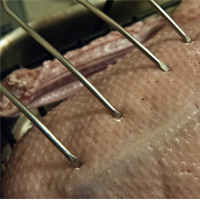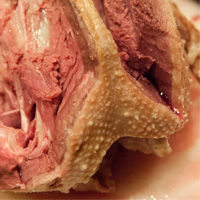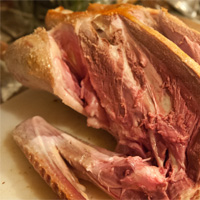Holiday Goose | Injected with Belgian Quadrupel and Roasted
 The rich meaty flavor of this holiday goose is well complemented by dried fruits like cherries, figs, prunes, raisins and apricots. A Belgian-style Quadrupel mimics these flavors with the malts, yeast and additional sugars that harmonize during fermentation. Goose benefits more from using beer injection to infuse flavor deep into the meat while marinating the fowl from the inside out. If the beer you select only comes in a 750-milliliter format, use the remaining beer for the Dried Cherry Quadrupel Sauce.
The rich meaty flavor of this holiday goose is well complemented by dried fruits like cherries, figs, prunes, raisins and apricots. A Belgian-style Quadrupel mimics these flavors with the malts, yeast and additional sugars that harmonize during fermentation. Goose benefits more from using beer injection to infuse flavor deep into the meat while marinating the fowl from the inside out. If the beer you select only comes in a 750-milliliter format, use the remaining beer for the Dried Cherry Quadrupel Sauce.
Serves: 6–8 people, depending on the size of the goose and the number of side dishes
Special Equipment:
1 each Thermapen Instant Thermometer
and | or
1 each ChefAlarm by ThermoWorks
1 each All-Clad Stainless Steel Large Roti Combo with Rack and Turkey Lifters
1 each Stainless Steel Commercial grade meat marinade flavor injector
Adapted from BeerAdvocate Magazine: Cuisine à la Bière | Nov 2015 | Issue #106
Check out my other Holiday Feast ideas, menu suggestions and recipes.
- 375 ml Quadrupel, such as Rochefort 10, De Struise Brouwers Pannepot, St. Bernardus Abt 12 or other Quadrupel
- 1 teaspoon salt, sea
- 1/2 teaspoon cinnamon, Celyon, ground
- 9-12 pound goose, whole, fresh or frozen, (thawed in the refrigerator for 3 days prior)
- 1 bunch thyme, fresh
- In a medium bowl, add the Quadrupel, pouring slowly to leave any sediment behind. Add the salt and cinnamon, mixing to combine and degas the beer, making it easier to fill the syringe. Set this aside to help dissolve the salt.
- When selecting a goose, look for a free range, naturally farmed fowl. Most likely you’ll have to order one, just as you would a turkey. Allow a frozen goose (around 10 pounds) three full days in the refrigerator to thaw.

- About 2 hours before you start cooking, remove your holiday goose from the refrigerator and place into a clean sink. Open the package and remove the neck, gizzards and liver from the cavity of the bird. Wash and rinse the goose, inside and out. Using a deboning knife, remove the wing tips, as they’re too tough to eat, and reserve for the Dried Cherry Quadrupel Sauce. Save the neck and organs for the sauce, too. Then, using paper towels, dry the goose as best as you can.

- Place the goose onto a rack, fitted with a roasting pan. A lasagna pan can be used as a substitute, with carrots and celery acting as a stand for the goose. Take a few minutes to clean and sanitize the sink and your workspace after you’re done preparing the bird.
- Under the skin of a goose is a thick layer of fat, which will render from the breasts and crisp the skin. With a carving fork, turkey lifter or a needle, make a grid pattern of small holes, deep enough to pierce the skin and partially into the fat layer, but not deep enough to poke the breast meat. Create roughly 20 holes per breast and about 10 per thigh. Sprinkle a good amount of salt over the whole bird and rub into the skin.

- Fill the syringe with the Quadrupel marinade and find the center of a breast. Inject the needle at an angle, squeezing in some of the marinade. Remove from the skin, turn it 15 degrees, and re-inject the breast meat. The idea is to create longer channels for the marinade. Make about 5 – 6 injections, using about a quarter of the marinade while making a full rotation of the breast. Repeat with the opposite breast.
- Next, poke a hole into a leg/thigh near the knee, going down the thigh, injecting the meat with the marinade. Poke a hole on the opposite side of the same knee and marinade the outside of the thigh. Do the same with each leg, starting from the top down, outside and inside the leg. Lightly wipe up any leaking marinade from the skin. Leave the goose to rest and warm up to room temperature. About 1 1/2 hours into this time, pre-heat your oven to 400°F | 204°C. If you have a probe-style thermometer, place it into the deepest part of a breast, making sure it’s not touching bone, as that can give a false reading.
- Place the goose into the oven and turn the heat down to 325°F | 163°C. Roast until the breast meat registers an internal temperature of 130°F | 54°C. This should take about 35 – 60 minutes, depending on the size of your bird and the kitchen’s room temperature. The goose will not be fully browned: this is OK. Remove the bird to a cutting board, keeping the oven on.

- Using rubber gloves and a sharp de-boning knife, cut each breast from the carcass. Cut to one side of the chest bone, keeping the edge of your knife parallel to the rib cage, slicing from the neck down to the cavity.

- Then cut around the wishbone, near the neck opening and down to the wing. Finally, cut the rest of the way, removing the breast in one piece. Repeat with the remaining breast. Place the breasts on a plate, covering with foil to keep warm. The leg meat will take longer to cook; return the carcass with the legs still attached back onto the roasting rack and place it in the oven. The legs are done when they are 180°F | 82°C internally, about another 1 – 1 1/2 hours.

- Using a de-boning knife, cut the leg/thighs from the carcass and set with the breast meat.

- The meat can rest for up to an hour if needed. This is a great time to finish the Dried Cherry Quadrupel Sauce. Just before serving, place a heavy skillet over medium high heat. Add some of the reserved goose fat and place the leg/thighs into the pan.

- Brown for 5 – 6 minutes, flip, add the breasts skin side down, and cook another 5 – 6 minutes. Remove from the pan and rest for a minute before slicing.

- Remove the goose from the pan and use the Dried Cherry Quadrupel Sauce, along with the remaining citrus juice to deglaze the pan. Using the flat edge of a spatula, scrape any fond from the browning pan and taste the sauce, adjusting with salt and pepper if needed.
- Cut the meat from the legs and thighs, slice it into small pieces and place it onto a warmed serving platter. Slice the breast meat into thin pieces and arrange onto the platter. Pour the finished Dried Cherry Quadrupel Sauce over the top and serve.


Notes:
The goose will release a lot of fat, which will collect in the bottom of the pan. Save this! It’s a wonderful fat for cooking potatoes, other vegetables, stuffing or pilaf. Save the carcass and use it later to make stock for a soup or sauce.




